Audio Valve Challenger 115/180 monoblocks
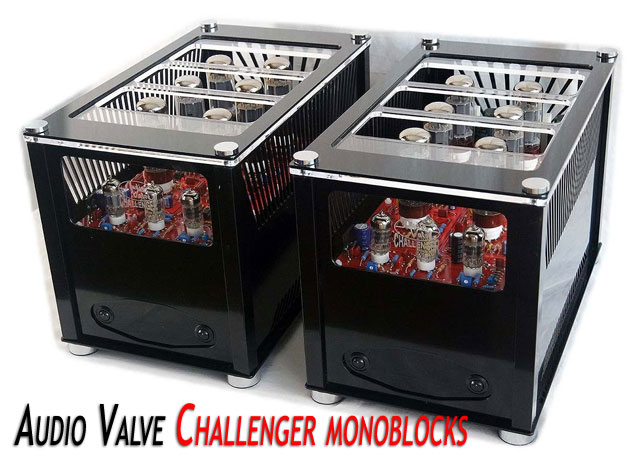
 Audio Valve is a high-end audio company located in Kassel, Germany. Founded by Helmut Becker, who developed a passion for tube technology early in his life which led to lifelong love affair with tube technology. His products are the result of fifty years experience beginning with his dad’s television repair business and a military stint working around large tubes like klystrons, magnetrons and tyratrons. All Audio Valve products are hand-made in Kassel, Germany. In 1982, Helmut Becker brought out his first patented project, the RKV OTL tube amplifier. Soon, he began developing semi-conductor-based products for audiophiles. Incredibly, Helmut Becker now holds about fifteen patents.
Audio Valve is a high-end audio company located in Kassel, Germany. Founded by Helmut Becker, who developed a passion for tube technology early in his life which led to lifelong love affair with tube technology. His products are the result of fifty years experience beginning with his dad’s television repair business and a military stint working around large tubes like klystrons, magnetrons and tyratrons. All Audio Valve products are hand-made in Kassel, Germany. In 1982, Helmut Becker brought out his first patented project, the RKV OTL tube amplifier. Soon, he began developing semi-conductor-based products for audiophiles. Incredibly, Helmut Becker now holds about fifteen patents.
 It is the Audio Valve Challenger monoblocks that are the foundation of Audio Valve design achievements, which have been refined and perfected over time since they were first introduced in 1987. The Audio Valve Challenger is a Class A design, a parallel -push-pull mono block amplifier with parallel-symmetrical-cross-coupled driver stage tubes. It utilizes six beam power pentodes, two 12AU7s, and one 12AX7. Uniquely, it can be fitted with three different types of tubes, the KT88, EL34, and 6550. My review pair came with EL34s. The power will varies depending on the tubes used, from 115 watts per channel to 180 watts per channel. This is made possible by Audio Valve’s patented revolutionary and proprietary Automatic Bias Regulator (ABR) circuitry, which brilliantly monitors, biases, and controls each tube independently. This feature allows the use of any of the aforementioned tubes or a combination of any of the three. It’s a truly innovative way to “plug and play.” The ABR technology makes tube replacement very economical as there is no need for costly and exotic tubes which have to be matched in order to get the best sound from the amplifier.
It is the Audio Valve Challenger monoblocks that are the foundation of Audio Valve design achievements, which have been refined and perfected over time since they were first introduced in 1987. The Audio Valve Challenger is a Class A design, a parallel -push-pull mono block amplifier with parallel-symmetrical-cross-coupled driver stage tubes. It utilizes six beam power pentodes, two 12AU7s, and one 12AX7. Uniquely, it can be fitted with three different types of tubes, the KT88, EL34, and 6550. My review pair came with EL34s. The power will varies depending on the tubes used, from 115 watts per channel to 180 watts per channel. This is made possible by Audio Valve’s patented revolutionary and proprietary Automatic Bias Regulator (ABR) circuitry, which brilliantly monitors, biases, and controls each tube independently. This feature allows the use of any of the aforementioned tubes or a combination of any of the three. It’s a truly innovative way to “plug and play.” The ABR technology makes tube replacement very economical as there is no need for costly and exotic tubes which have to be matched in order to get the best sound from the amplifier.
Next to each tube is a red LED which glows in stand-by mode, and goes off when the standby switch is set to “on”. Should a tube ever veer from its correct operating range, the LED glows, telling the user its time for a replacement. Unfortunately, a couple of months into this review, one of the output tubes, EL 34, veered out of operating range and had to be replaced with a new tube. It only took a minute to remove the plexiglass lid and tube changing was a easy and simple. Once fitted with a new tube the Challenger was reliable throughout my review.
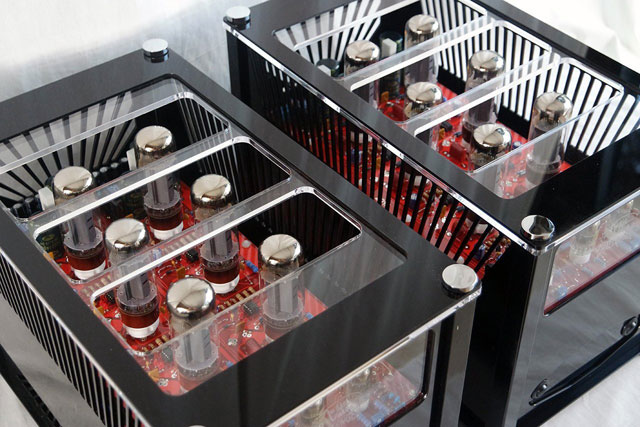
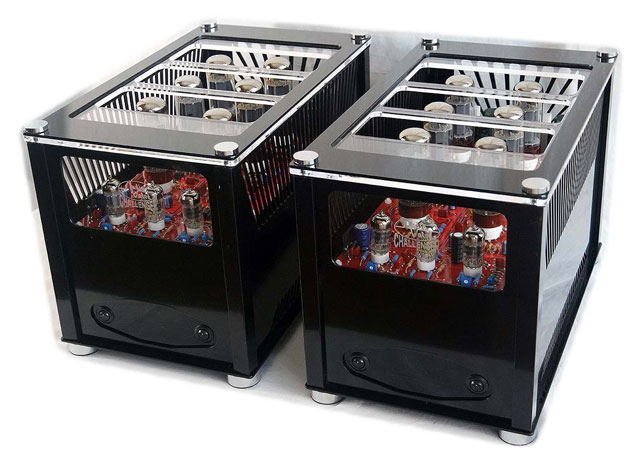
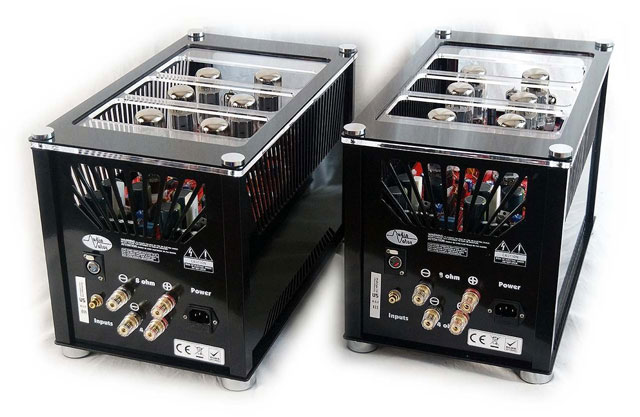
The Challengers were delivered in two separate heavy- duty boxes. Fortunately, they were easy to unpack and it was a breeze to set them up. (It only took about 15 minutes). At first glance, we can see this is not what we might typically expect in a traditional German product. Looking at the plexiglass cover, I was reminded of a 1970’s of retro design. Cleverly, it has a stand-by switch on the front panel which doesn’t need to be turned off after each listening. When on stand-by, it turns down the anode voltage to longer intervals without shutting the amplifier down. The tubes stay warm and can deliver the maximum of musical quality instantly after switching-on the amplifier.
My new reference Hemingway Audio Creation Ultimate Signature balanced interconnects (XLR) linked the Challengers to a Thrax Audio Dionysos preamplifier. The Challenger has separate speaker terminals for 4 and 8 Ohm loads. I used the 8 Ohm tap with my Consensus Audio Engineering Conspiracy and the system sounded best through the 8 Ohm tap on the Audio Valve amplifier. I used the Challenger in my reference system, in place of my Thrax Teres mono amplifiers. The Pi Greco Sinfonia CD player, used as a transport, was paired with the ultimate sounding Thrax Maximinus DAC and a Thrax Dionysos preamplifier while Hemingway Audio Creation Ultimate Signature cables were used throughout the system. In addition to my Consensus Audio Engineering Conspiracy loudspeakers, I also spent some time with a new addition to my reference loudspeakers, the Thrax Lyra loudspeakers.
 The distributor, Alfred Kainz, informed me that the Challenger needed a good long burn-in for optimal sound. However for me, the Challenger sounded very good right out of the box. I normally would burn-in for about a month or so before doing any serious listening but with the Challenger I started to listen right away. When I started listening immediately it put a smile on my face. I really liked what I heard. The Challenger was very involving and authoritative with excellent dynamics. Music of all kinds flowed effortlessly. Once settled in, a 20-minute warm-up or so from cold seemed sufficient for it to reach a good operating plateau and everything went smoothly. As I spent more time listening to the Challenger the sound continued to improve. The Challenger was so silent from my listening seat that I felt no need to put my ear to my loudspeaker’s tweeter to see if I could detect any hiss or buzz.
The distributor, Alfred Kainz, informed me that the Challenger needed a good long burn-in for optimal sound. However for me, the Challenger sounded very good right out of the box. I normally would burn-in for about a month or so before doing any serious listening but with the Challenger I started to listen right away. When I started listening immediately it put a smile on my face. I really liked what I heard. The Challenger was very involving and authoritative with excellent dynamics. Music of all kinds flowed effortlessly. Once settled in, a 20-minute warm-up or so from cold seemed sufficient for it to reach a good operating plateau and everything went smoothly. As I spent more time listening to the Challenger the sound continued to improve. The Challenger was so silent from my listening seat that I felt no need to put my ear to my loudspeaker’s tweeter to see if I could detect any hiss or buzz.
Moreover, the challengers deliver in spades the full musical thrill of which tubes are capable. Voices and all musical instruments rendered by the Challengers possess a richness of tonal colors that comes closer to the real thing than solid-state can. I don’t mean that its sound is slow and syrupy. It is not. It is fast, transparent, and fully extended at both frequency spectrums. The Challenger’s lowest octaves were in no way soft or lacking in either full extension or dynamic punch.
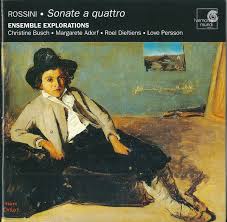 I really enjoyed listening to chamber music and the first recording I played was one of my favorites: Rossini’s Sonate a Quattro performed by Ensemble Explorations (HMC901776). The Challenger’s ability to resolve subtle musical information was excellent. The strings were lovely throughout this recording; they were detailed and very involving emotionally, revealing layers of fine detail and nuance that were outstanding. The midrange was rich and attractively sweet, without sounding too warm. The treble was very extended, and was reproduced cleanly with an airy extension.
I really enjoyed listening to chamber music and the first recording I played was one of my favorites: Rossini’s Sonate a Quattro performed by Ensemble Explorations (HMC901776). The Challenger’s ability to resolve subtle musical information was excellent. The strings were lovely throughout this recording; they were detailed and very involving emotionally, revealing layers of fine detail and nuance that were outstanding. The midrange was rich and attractively sweet, without sounding too warm. The treble was very extended, and was reproduced cleanly with an airy extension.
The Challenger’s rendering of concertos and symphonies was equally impressive. One weekend I was listening to concertos and I put on a beautiful vinyl recording of Beethoven’s piano concerto N0.4 in G Major, Op. 58 (stereo 2335 426-10). It was performed by Wilhelm Kempff under the maestro Ferdinand Leitner conducting the Berlin Philharmonic Orchestra and it sounded exceptionally captivating: the piano and orchestra were outstanding. The Challenger has the ability to capture the full sweep, warmth, and complexity and the magnificence of the orchestra’s dynamic range. At the same time, it allowed Kempff’s piano to take center stage. Nor did the Challenger shy away from large-scale symphonic works. Listening to Dvorak’s Symphony 9 in E Minor, Op.95, with Fritz Reiner conducting the Chicago Symphony Orchestra (JVCXR-024), produced enormous size, scale, and powerful dynamic swings. I was delighted to discover that the Challenger was capable of rendering a stunningly a three-dimensional illusion with a huge, wide and deep landscape and a perspective that makes my loudspeakers disappear.
Lately I’ve been exploring the tube realm, and the more I listen to tubes the more I like them. I must say, tubes do something to the music and I really enjoyed my time listening to the Audio Valve Challenger mono-block amplifiers. The amp had no problem driving the Conspiracy and the Lyra loudspeakers with great control and finesse. Hats off to Helmut Becker! I highly recommend the Audio Valve Challengers. It is fine German engineering that comes with sensible pricing in today’s high-end audio arena.


key kim
Specifications: Audio Valve Challenger 115/150/180 mono-block amplifiers
Price: $10,500 per pair
Parallel-push-pull power amp with parallel-symmetrical-cross-coupled driver stage
Tubes: 2, 12AU7, 12AX7, 6 beam power pentode: KT88, EL34, 6550
Operation: Class-A
Power output: 115 Watt (EL34)/150 Watt (KT88 or 6550)/ 180 Watt/ (KT88 or 6550)
Power consumption: 320 Watt – Stand by mode – 80 Watt
Max. short circuit current: 70 ampere between 2 ohm terminals
Input sen: 0 dBm
Input imp: 2* 47k
Output imp: 4-8 ohm
Connectors: LR & RCA input-jackets
Power bandwidth: 5-40,000 Hz
Distortion: 0.3% – 50 Watt (8 ohm load)
Damping: 5
Bias: auto, controlled with “ABR” for all power tubes
Stand-by mode: switchable
Dimension: 43 x 28 x 24 cm, D-H-W
Weight: 48 pound each
Audio Valve
Dormannweg 48 B
KADRUF – Gewerbepark
34 123 KASSEL
Germany
e-mail: info@audiovalve.info
Tel: +49 561 7013360
US Distributor:
highend-electronics, Inc.
Alfred Kainz
19593 Roanoke Road
Apple Valley, CA 92307
Phone: 760-490-2410
e-mail: office@highend-electronics.com
http://www.highend-electronics.com
Stereo Times Masthead
Publisher/Founder
Clement Perry
Editor
Dave Thomas
Senior Editors
Frank Alles, Mike Girardi, Russell Lichter, Terry London, Moreno Mitchell, Paul Szabady, Bill Wells, Mike Wright, and Stephen Yan,
Current Contributors
David Abramson, Tim Barrall, Dave Allison, Ron Cook, Lewis Dardick, John Hoffman, Dan Secula, Don Shaulis, Greg Simmons, Eric Teh, Greg Voth, Richard Willie, Ed Van Winkle, Rob Dockery, Richard Doron, and Daveed Turek
Site Management Clement Perry
Ad Designer: Martin Perry






Be the first to comment on: Audio Valve Challenger 115/180 monoblocks